Japanese Literature and Film
Many of
the themes commonly found in Japanese romances portrayed in literature and film
can be found within Final Fantasy VII. Foremost in Japanese romance as evidenced
in cinema and popular culture is the idea of fukano na, or the
impossible. Cinema in Japan is rife with this sub theme. Another central theme
in Japanese romance is perseverance, or gambare. So to persevere in the
impossible, way beyond any rational or realistic expectation, is a very strong
theme in Japanese stories of romance.
(From
Japanese cultural and language expert Matt at
All Experts.com)
Given
that this theme is so common within Japanese romance, it becomes clear that
Cloud does indeed intend to go back to Aerith when he says, “I think I can meet
her… there”, in the final FMV. Some in the Western audience protest that Cloud
would be pursuing the impossible by planning to be with Aerith after her death.
However, this kind of perseverance to do the impossible out of love for someone
is commonly found in the tragic love stories of Japan, even if the goal is
beyond rational or realistic expectation.
 Another
argument heard among Westerners is that Cloud would choose to move on and enjoy
life with Tifa rather than remain in love with Aerith’s spirit. Some even say
that Cloud would have to die in order to have a relationship with Aerith after
her death. Again, these are arguments based on Western cultural ideas, and the
Japanese perspective is different. If we go on to examine the common themes of
tragic love stories in Japan, we learn that committing seppuku, or ritual
suicide, for the sake of love is a common idea.
Another
argument heard among Westerners is that Cloud would choose to move on and enjoy
life with Tifa rather than remain in love with Aerith’s spirit. Some even say
that Cloud would have to die in order to have a relationship with Aerith after
her death. Again, these are arguments based on Western cultural ideas, and the
Japanese perspective is different. If we go on to examine the common themes of
tragic love stories in Japan, we learn that committing seppuku, or ritual
suicide, for the sake of love is a common idea.
From
Matt at
All Experts.com:
“Seppuku, or ritual suicide, is not unheard of even today, especially
among lovers.”
The
love suicide is a very popular theme of tragic love stories
in Japan, which started with a genre popular in the 18th century Japanese
kabuki puppet theaters. In these stories a pair of lovers, unable to
come together in life, commit suicide in the hope of escaping their earthly
obligations and being reborn together in paradise. These stories were wildly
popular in their own day, and the themes and images continue to appear in
contemporary popular culture, from TV soap operas to anime.
A Bunraku Play: Sonezaki Shinju
Bunrako - Japanese Puppetry
The Love Suicides at Sonezaki, which was very popular with audiences in
Osaka, Japan, originates entirely outside the Western tradition. It was written
as a puppet drama in 1703, and has become a literary milestone in Japan. The
final scene, as the lovers steal into the forest by night to take their lives,
is considered to be one of the masterpieces of Japanese literature. The tragedy
in Love Suicides is that Ohatsu and Tokubei can’t elope. He’s ruined,
financially and socially, and she’s indentured, almost a slave. They’re about to
be separated forever, and that would be unbearable. So, they resolve to die
together. And for the play to succeed, they need to die beautifully, “a model of
true love.”
Arts & Culture: The Love Suicides at Sonezaki
Although this kind of thinking is unpalatable to many in the Western audience,
it is seen as “a model of true love” in Japanese literature, and the concept is
popular even today in Japan. We have seen that Cloud and Aerith were connected
by a thread of true love in the symbolism of the Japanese. Therefore, it is not
impossible that Cloud, unable to come together in life with Aerith, decides to
do this after defeating Sephiroth in order to be reborn together with Aerith in
paradise. Cloud’s words in the final FMV, “I think I can meet her… there”,
indicate that Cloud chooses to go back
to Aerith. Is there an alternative way for Cloud to
be with Aerith after her death? Let’s look at
another possible meaning of Cloud’s words.
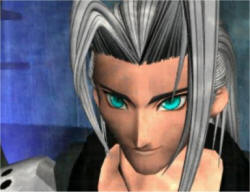
Life
After Death
In
Japan the majority of Shintoists are also Buddhists, to one degree or another,
so the Shinto religion is compatible with different beliefs and opinions of an
afterlife. Of those who are Shinto, but not Buddhist, one fairly common view is
that when one dies, one's spiritual energy, or soul, maintains its distinct form
for a period of time. The specific number of years varies, but it's roughly two
human generations. During this time, one's family and friends can "call" on the
deceased for advice and assistance, or even "just to chat". After two
generations, the deceased's spiritual energy loses much of its distinctiveness
and "merges" with the spiritual energy of other family ancestors to become a
kind of "collective ancestral kami". This is not the only view, of
course, because Shinto is not particularly dogmatic in these matters. However,
spirit energy is generally considered to be eternal, and therefore it must
continue in one form or another.
Considering Shinto: Beliefnet
In
Japanese culture, the body and the soul are forever connected, even in death.
The afterlife is not just that of the
soul, but of the body and soul. The two cannot be separated.
Calling Off Search to Yield Endless Grief
According to Shinto belief, every person after death becomes a kami, a
supernatural being who continues to have a part in the life of the community,
nation, and family, while existing in another state or dimension.
Comparative Beliefs of the Afterlife by Several Major Religions

From a
Japanese standpoint, the “soul” or “spirit” of the deceased maintains a distinct
form for roughly two human generations before merging with the collective
spiritual energy of others who have passed away. The concept of the Lifestream
is quite similar to this view of spirit energy being eternal and capable of
merging with the spirit energy of others who have passed away. Aerith’s spirit
has maintained a distinct form within the Lifestream, which we see in her
picture at the end of the game. Would Aerith be accessible to Cloud within the
Lifestream?
Several
Paths, One Destination
by
ShroudedG
The
ending scene, a tangled riddle on it's own. It can lead through several
different perspectives, several different views, several different
interpretations. Yet, no matter how much you twist it, bend it and squeeze it,
there is only one conclusion...
Several
paths, one destination....

It can
be seen right here, Aerith's hand reaching out for Cloud… Cloud in turn reaching
out for hers. Separated by fate and by death… yet this moment alone shows how
even Death is powerless in the face of Cloud and Aerith’s desire to be together
again, even if it's impossible...
As
stated earlier: “Foremost in Japanese romance as evidenced in cinema and popular
culture is the idea of fukano na, or the impossible. Cinema in Japan is
rife with this sub theme. Another central theme in Japanese romance is
perseverance, or gambare. So to persevere in the impossible, way
beyond any rational or realistic expectation, is a very strong theme in
Japanese stories of romance.” (From Matt, at
All Experts.com)

Going
against the impossible… a riddle within a riddle.
An
answer from the Planet…
the Promised Land…
I think I can meet her… there
 The
Promised Land, another of the story's open-ended themes... a riddle within a
riddle… yet do we really need to solve this riddle to make a logical conclusion?
Or are we overlooking the simple fact that Cloud believes he can meet someone
who died right in front of him? Someone who we thought was lost forever?
The
Promised Land, another of the story's open-ended themes... a riddle within a
riddle… yet do we really need to solve this riddle to make a logical conclusion?
Or are we overlooking the simple fact that Cloud believes he can meet someone
who died right in front of him? Someone who we thought was lost forever?
To
believe in something way beyond any rational or realistic expectation. A
very strong theme indeed...
…but
what of Tifa? What part did she actually play in that scene and those
statements? She is an integral part of the Love Triangle discussion and should
not be overlooked in this analysis. To fully elaborate, we need to look at how
important Cloud is to Tifa. Remember the first time Tifa found Cloud in a
comatose state, look carefully at what she gives up in order to be at his
side...

Tifa:
“I don’t care about anything else, only Cloud…”
(She
turns to face them.)
Tifa:
I… want to be by his side…”
Cid:
“Yeah. Right. Hang in there, Tifa.”
Barrett: “Yeah, that’s probably best…”
“For Cloud… an’ for you…”
(She
nods, but doesn’t bring her head back up, looking at the floor.)
Tifa:
“I’m sorry, everyone… At a time like this…”
This
scene alone shows that Tifa will do anything for Cloud, no matter what the cost.
This is what Tifa does for Cloud. She is an unselfish individual who will give
everything for him to be happy.

for him to be happy...
There
is something in her quick agreement to meet Aerith that just isn't right for someone who has taken
place as Cloud's new love interest. She believes him without even questioning
why Cloud suddenly says, “I think I can meet her… there”. No questions asked, no
doubt in her words.....
.....acceptance
How so?
As I stated before, the ending scene can lead you through many paths, but I've
yet to find another logical conclusion different from my own. In order to accept
what should be accepted, you first need to understand the reason behind it...and
so I will provide one path that I believe is most logical. Remember the scene
when Cloud's party was thrown in jail in the Shinra Building, the time when Tifa
asked Aerith what the Promise Land is…

Tifa:
EXCUSE me. You know, Aerith. I have a question.
Aerith: What?
Tifa:
Does the Promised Land really exist?
Aerith: ...I don't know. All I know is... The Cetra were
born
from the Planet, speak with the Planet, and unlock the Planet.
And......then...
The Cetra will return to the
Promised Land.
A land that promises supreme happiness.
Tifa:
...What does that mean?
Final Fantasy VII Script at RPGamer
We
still don't know what the Promised Land truly is, but we do know that it does
provide supreme happiness to those who reach it. Whatever it is, Cloud wanted to
meet her there... because with Aerith, Cloud is truly happy. Tifa finally
understood what it meant… and at that point, Tifa makes a sacrifice which rivals
Aerith's own sacrifice. Her own happiness… for Cloud.

Pragmatism vs. Idealism: Fairy Tales
by Karma
Hunter
Speculation about the love triangle of Final Fantasy VII often makes one lose
sight of what the whole of the game comprises: the theme of Life. The love
triangle is relevant to this theme since it is basically a mirror for the
choices in Life itself. Although Cloud is thrust into glorious and often
fantastical situations, the love situation is just as typical (and just as
stupefying) as one we ourselves would encounter. The choices of Life are
revealed in the choices which Cloud makes.
In
Life, the pragmatist will make the sensible choices, choosing to opt out of
dreams simply because they are unreasonable. The idealist, on the other hand,
strives to attain the ultimate result in Life. The idealist may be much more
likely to fail, but the potential rewards that it offers are too much to ignore.
We are reminded:

"We are
only given one life to live. Remember, when appropriate, to live it."
Pragmatism is a paradox. It presumes to be the most sensible and logical way to
live one's life, yet results in being completely unsatisfying in every
conceivable way. Why? Among other things, pragmatism cannot sustain those who
choose it. A pragmatic solution intentionally shortchanges the pragmatist. The
pragmatist can never attain everything that Life has to offer, just as Cloud
will never attain everything that Life and love have to offer if he chooses
Tifa.
But if
Cloud becomes the idealist, if Cloud dares to love Aerith, despite the risks in
doing so, regardless of whether she is alive or dead, and his love is constant
beyond death, then his love for Aerith is ultimately more cherishable than
anything that he could ever have with Tifa.
The
ultimate problem of Life: does one consign oneself to the ordinary vision of the
status quo, or does one risk everything in order to attain the highest form of
the self? In Final Fantasy VII, the answer is obvious. Taking the easy answer of
pragmatism is not an option, for it embodies Life at a standstill, which is what
the Shinra and corporate pragmatists of our world do. Only idealism, according
to Final Fantasy VII, can save mankind from itself, before our Holy in the form
of Nature itself relieves us.
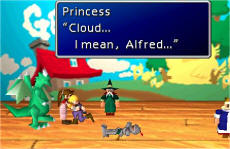 The
theme of Life in Final Fantasy VII encompasses all of its virtues. And it has an
end. Through the betterment of mankind and the fight for an ideal world, Life
itself becomes a Fairy Tale.
The
theme of Life in Final Fantasy VII encompasses all of its virtues. And it has an
end. Through the betterment of mankind and the fight for an ideal world, Life
itself becomes a Fairy Tale.
Subsequently, so does its love story. The ideal search embodied in the love of
Cloud and Aerith continues to live on in lore, from outlandish fanfic tales of
resurrection to actual representation of their ongoing search for love in games
such as Final Fantasy Tactics and Kingdom Hearts,
which prove that at the end of it all, Cloud is with
Aerith in spirit, if not in body.
And in
Final Fantasy VII, this is revealed to be the only thing that matters.
“I think
I can meet her… there”
interpretation by Li Mu Bai
Let’s
examine more closely Tifa’s reaction to Cloud in the final FMV at the moment he
chooses to meet Aerith. Some people claim that Tifa snuggles up to Cloud and
smiles during the scene where they are hanging off the ledge. In actuality, Tifa
makes a gesture of this sort only in the scene below, which is before Cloud
says, “I think I can meet her… there”.

Once
Cloud makes his choice to go to Aerith, Tifa makes no more movements of this
sort. Instead, you can see her initial response to Cloud’s words in the picture
below. Her reaction is obviously one of dismay and shock, rather than pleasure.
At this point, Tifa realizes that Cloud will return to Aerith, and that Aerith
will always be first in his heart.

After
her initial reaction of dismay, Tifa’s facial expression changes. At this point,
some people say that Tifa smiles. However, if you study the close up of her
mouth below, you will see that Tifa is not actually smiling. Instead, her lips
are pursed together, almost in a frown. It is simply a visual illusion that Tifa
is smiling, largely due to the camera angle on the curve of her face. If you
focus on Tifa’s eyes, she does appear to be smiling. However, if you focus on
her mouth, Tifa’s expression is actually that of a lost soul.


Even if
Tifa were smiling here, a smile is not necessarily an indication of pleasure or
happiness for the Japanese. The smile can often be an expression that conceals
embarrassment, pain, or anguish. In an uncomfortable situation it is not
uncommon for the Japanese to give a nervous laugh or awkward smile to conceal
the true emotion.
The Japanese Smile
Japanese Culture: Non-Verbal Communication
Tifa’s
last response to Cloud is to bow her head in submission and resignation. Tifa
does not snuggle against Cloud as she does this, although some people say that
she does. Instead, she simply lowers her head, which is a gesture equivalent to
a bow in Japanese society when made to a person with whom you are familiar.
Besides, Tifa is unable to bow anything but her head as they are hanging in
mid-air off the ledge. In the tradition of the Japanese, a bow represents
humility and the desire to honor and respect another person. As Tifa says,
“Yeah, let’s go meet her”, she is honoring Cloud’s wish to go to Aerith.
Japanese Culture: Bowing
Bowing in Japan
Geisha:
A Review

Again,
we are seeing the element of self-sacrifice here, and one that demonstrates
Tifa’s love for Cloud. As discussed earlier, the karmic balance of the world is
such that nothing is gained without something else being lost, according to the
Japanese. In shoujo and bishoujo stories, a sacrifice can be
something as extreme as death, or giving up on your own hopes and dreams so that
someone else can accomplish theirs.
Symbolism in Anime: Love and Friendship Out of her love for Cloud, Tifa
sacrifices her own happiness so that Cloud may follow his own dream… to be with
Aerith, his light.

We'll always be together
No matter what the time
Because you're by my side
The light known as "you" finds me
In the middle of the night
-Utada Hikaru, Hikari (Light)
Kingdom Hearts
Possible
Outcomes
If the
Shinto concept of a kami, or spirit, maintaining a distinct form for two
generations after death is generalized to Aerith’s spirit, then she would indeed
be accessible to Cloud within the Lifestream so that he could “meet her… there”.
We see that Aerith has maintained a distinct form within the Lifestream in her
final picture. Cloud and Tifa were able to visit the Lifestream during the event
in Mideel where Cloud remembers his true place in the happenings at Nibelheim.
Cloud and Tifa were also able to swim out of the Lifestream after that event.
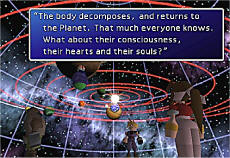
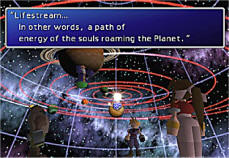
We saw
that the spirits of the Lifestream were able to communicate with Tifa when she
first fell into the Lifestream at Mideel. We know, too, that the spirits of the
Cetra are able to communicate with the living, as Aerith was able to do with the
spirits in the Temple of the Ancients. Cloud was even able to hear the voices of
the Cetra in the Forgotten City when he touched the white orbs found there.
Although Cloud wasn’t able to comprehend what the Cetra spirits were saying to
him, Aerith explained in the Temple of the Ancients that the spirits of the
Ancients had lost their ability to communicate with language in a way
understandable to humans over time.
At the temple of the Ancients:
 (Cloud navigates the maze. There is a little rabbit-
(Cloud navigates the maze. There is a little rabbit-
like
creature, the lagomorph from Final Fantasy 6,
that
he chases until he eventually catches it in a
small
room.)
Lagomorph: “nyum… nyum…”
Aerith: “Phew! We finally caught up to you.”
“I’m
sorry. You waited for me.”
“Those are the spirit bodies of the Ancients.”
“They’ve been away from their Planet for a
long
time to protect the Temple.”
“Over the many years, they’ve lost the ability to talk.”
The Complete Final Fantasy VII Script at RPGamer
Since
Aerith had only recently died, her spirit wouldn’t be faced with that
difficulty. Notice that Aerith refers here to the “spirit bodies” of the
Ancients, which implies that spirits are capable of maintaining a distinct form.
The Jenova cells present in Cloud would make it possible for him to endure time
within the Lifestream more easily than a normal human being. Although Cloud
wouldn’t be able to stay in the Lifestream for lengthy periods of time, it would
indeed be possible for him to visit with Aerith’s spirit there.
A
second alternative discussed earlier would be that Cloud intends to commit
seppuku, or ritual suicide, in order to be reborn with Aerith in paradise.
As you remember, this concept is widely accepted in present day Japanese
culture, and is considered to be an act of true love.
The
third alternative is that human life is extinguished by the Lifestream as it
destroys Meteor, and that Cloud is able to join Aerith in spirit when that
happens. However, this alternative depends upon the player’s interpretation of
the ending, and whether or not the player believes that humanity survived at the
end of the game.
What
matters is that we know Cloud and Aerith were joined by a ribbon of true love,
and that Cloud intends “to meet her… there”. It’s up to the player to decide in
what way Cloud did that.
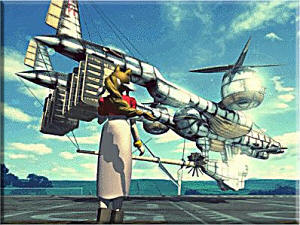
Aerith: “Hey, Cloud. Did you see the Airship at Junon?”
Cloud: “… I heard it was big, but I didn’t expect it to be THAT big.”
Aerith: “That was REALLY something. Hey, do you think I could get on it?”
Cloud: “I’ll take you someday… “
Aerith: “Wow! I’m really looking forward to it! Let’s ride the Airship together,
OK?”
Associated
Websites
Destiny Fulfilled: Cloud and Aerith's Love
Comparing Cloud’s Affection for Aerith and Tifa
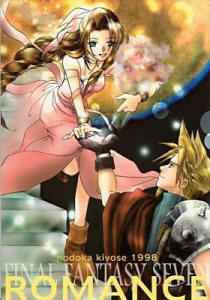 Links
Links
Hikari: An Answer From the Planet
The Flower Girl in the Slums
The Flower Girl and the Soldier
Never: The Fanlisting Against Cloud x Tifa
Symbolism in Anime
Credits
and Special Thanks
To Mike
Thomas at
Symbolism in Anime
To Matt
at
All Experts.com
To Gman
at
Beatrush.com
To the
authors and Cloud/Aerith supporters at:
Gamefaqs Final Fantasy VII Discussion Board
*
ShroudedG, author: Several Paths, One Destination
* eternal
yuna, author: Kingdom Hearts
* Li Mu
Bai, interpretation:“I think I can meet her… there”
* Karma
Hunter, author: Pragmatism vs. Idealism: Fairy Tales
*
Alysandra, author:The Influence of Japanese Culture
*
Perceivence, our fearless leader…
*
Carlatta, always with wonderful ideas…
*
MyWorldIsSquare, a great debater!
Send questions or
comments to [email protected]
Flames will not be
answered.
Web page
design and screenshots: Alysandra
To Kalanis, with thanks
for everything...
*Disclaimer:
Square has given no official interpretation of the Final
Fantasy
VII Love Triangle. The interpretations made on this site are
those of
the authors based on the documentation provided by hyperlink.
Reverse
Home

~ The Love Triangle of Final Fantasy VII is
further discussed at
Destiny Fulfilled: Cloud and Aerith's Love
 Another
argument heard among Westerners is that Cloud would choose to move on and enjoy
life with Tifa rather than remain in love with Aerith’s spirit. Some even say
that Cloud would have to die in order to have a relationship with Aerith after
her death. Again, these are arguments based on Western cultural ideas, and the
Japanese perspective is different. If we go on to examine the common themes of
tragic love stories in Japan, we learn that committing seppuku, or ritual
suicide, for the sake of love is a common idea.
Another
argument heard among Westerners is that Cloud would choose to move on and enjoy
life with Tifa rather than remain in love with Aerith’s spirit. Some even say
that Cloud would have to die in order to have a relationship with Aerith after
her death. Again, these are arguments based on Western cultural ideas, and the
Japanese perspective is different. If we go on to examine the common themes of
tragic love stories in Japan, we learn that committing seppuku, or ritual
suicide, for the sake of love is a common idea. 




 The
Promised Land, another of the story's open-ended themes... a riddle within a
riddle… yet do we really need to solve this riddle to make a logical conclusion?
Or are we overlooking the simple fact that Cloud believes he can meet someone
who died right in front of him? Someone who we thought was lost forever?
The
Promised Land, another of the story's open-ended themes... a riddle within a
riddle… yet do we really need to solve this riddle to make a logical conclusion?
Or are we overlooking the simple fact that Cloud believes he can meet someone
who died right in front of him? Someone who we thought was lost forever?




 The
theme of Life in Final Fantasy VII encompasses all of its virtues. And it has an
end. Through the betterment of mankind and the fight for an ideal world, Life
itself becomes a Fairy Tale.
The
theme of Life in Final Fantasy VII encompasses all of its virtues. And it has an
end. Through the betterment of mankind and the fight for an ideal world, Life
itself becomes a Fairy Tale. 









 Links
Links